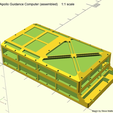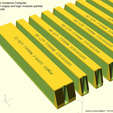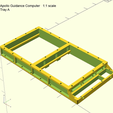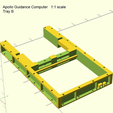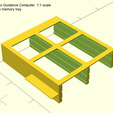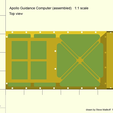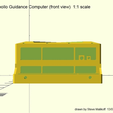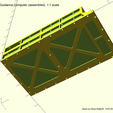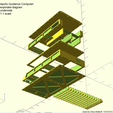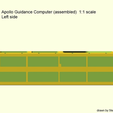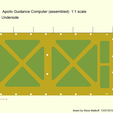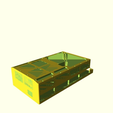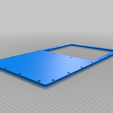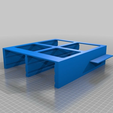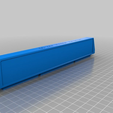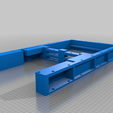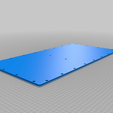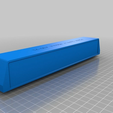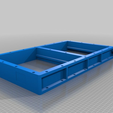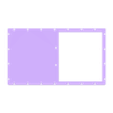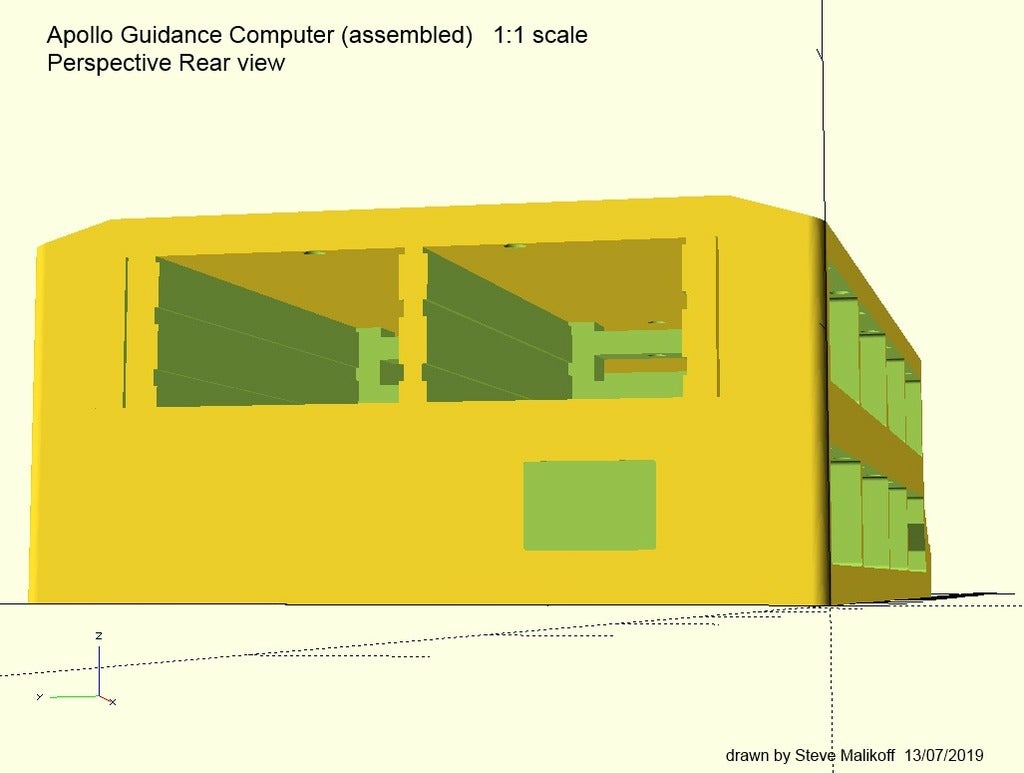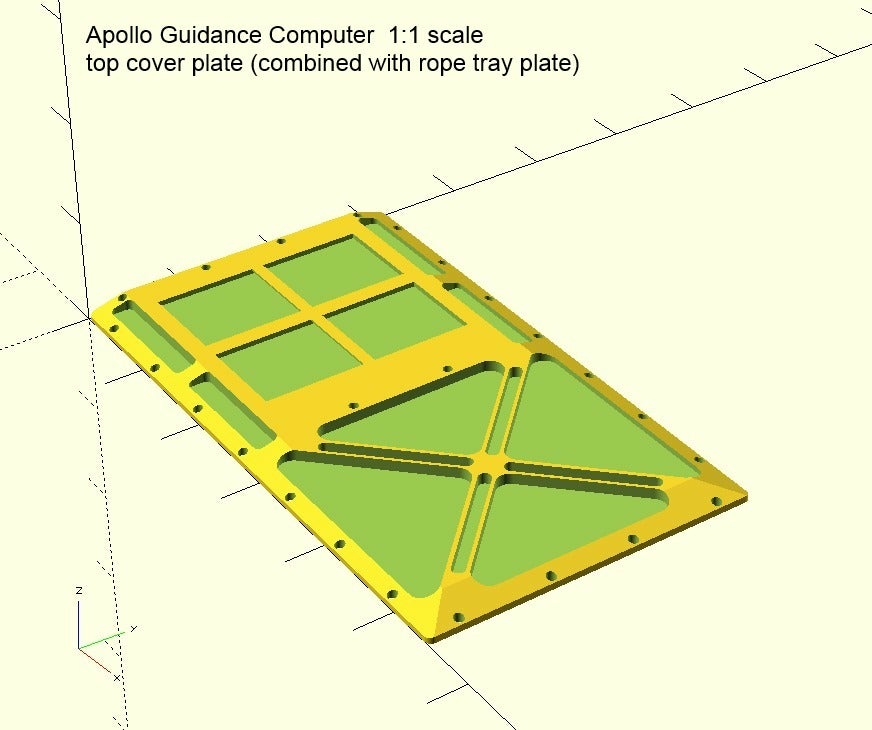Coming up to the 50th anniversary of the first moon landing, I've been amazed by the efforts of Marc, Mike, Ken and Carl in getting an AGC operational, all made possible by Jimmie saving the AGC way back when. If you haven't seen it, search for the AGC restoration series by Curious Marc on YouTube and start at Part 1.
Seeing as there are a few DSKY models around I thought I'd tackle the AGC computer chassis itself. Until recently, measurements for it have been a bit vague but now these have been made possible by Mike's PDF scan of Don Eyles' AGC manual from MIT:
https://archive.org/details/agc_handbook_jp2
This PDF has acceptably good drawings of the AGC trays, cover plates and the like, of what I resume to be an earlier(?) version of the casing. To get reasonably accurate extraction of dimensions from that document I've corrected a number of the drawings mostly by rotating the images, often by fractions of less than one degree prior to overdrawing in CAD to produce the 2D plan, elevation, front and back views. These are all then scaled individually to the correct size.
Additional details have come from Marc's excellent videos on Youtube where I have taken frame grabs which I loaded into CAD then applied some basic photogrammetry.
These and other photos are all I've used. I am aware Mike has some SVG's on his site of the chassis trays but I have not referenced them, preferring to stick to all my own work.
COMPONENTS
The model presented here is full size, the AGC being approximately 607.49mm long (deep) by 315.8mm wide by 151.36mm high (23.9" long x 12.43" x 5.96" high).
The component functions of this model are (so far):
Lower cover plate
Lower tray A
Middle plate
Upper tray B
Rope memory frame
Top cover plate
Logic module
Power supply module
These are displayed in an exploded format in one of the pictures.
SCALES
I'ts unlikely you'd want to print the model at full size, but at a smaller scale. To change the scale of the model, simply adjust the SCALE variable at the top of the script (for now). The default size, and of the STLs here is 1:1 scale.
eg. some possible scales you might like to try
SCALE = 1; // full size "one cubic foot". It could make an interesting PC case :)
SCALE = 1/5; // Raspberry Pi Model 3B case size, but needs some holes punched through the trays for the RasPi plugs and sockets (TODO).
SCALE = 1/6; // Suitable for 1/6 scale figures, eg. GI Joe
SCALE = 1/12; // Major Matt Mason doll size, also keyring fob size.
You could also adjust the scale in your slicer. See the note about smaller scales.
INCOMPLETIONS AND INCONSISTENCIES
As this is a work in progress I wanted to get the basic gist of the model up onto Thingiverse before the 20th of July. There are many things left to do, clean up, adjust and so on.
I need to study the rope tray frame a bit more to determine its shape better. In the Moon Machines AGC episode they show it being flipped over and inserted into Tray B. And I'm not even sure about the middle plate, but that seems evident in the MIT footage. Also the restored AGC has differences to the one in the MIT handbook.
One problem is at 1/6 scale, the walls of the frames are existentially thin and don't print well, neither does the bottom cover plate. The model may need to have a fudge factor added for the wall thickness at this scale. Also the screw holes are very close to the tray edges
TODO
Logic modules completion
Rope memory modules
Rope tray flanges, end connector orifices and jackscrew holes
Square up cloverleaf and recesses on top cover
Panel separation lines on top cover rope frame area
Main connector and test connector
Tray B intermediate bulkhead and intertray connector plugs
Test connector cover
Miscellaneous brackets and fittings
Reduce the number of magic number measurements in the script
Different bottom panel and Tray B front for restored AGC version
Add missing fillets and rounded corners
More screw holes
Some way of fixing all the parts together using the screw holes or clips
Fudge factor wall and plate thicknesses for small scales
Raspberry Pi connector plug cutouts
Raytheon nomenclature plate. I intend to do an affine transformation on a skewed frame grab from one of the AGC videos
Add some photos of my model print
NOTE
This AGC model is not for commercial use. Rather, I'm hoping it will get to the point of being sufficiently detailed that it could perhaps be educational. If I can find a good scale drawing of the IMU 'basketball' then that could be a consideration for modelling in future.

/https://fbi.cults3d.com/uploaders/16254473/illustration-file/0636d0e9-1097-4bc7-86c2-dd8f0ac22922/AGC_assembled_1_1_scale.png)
